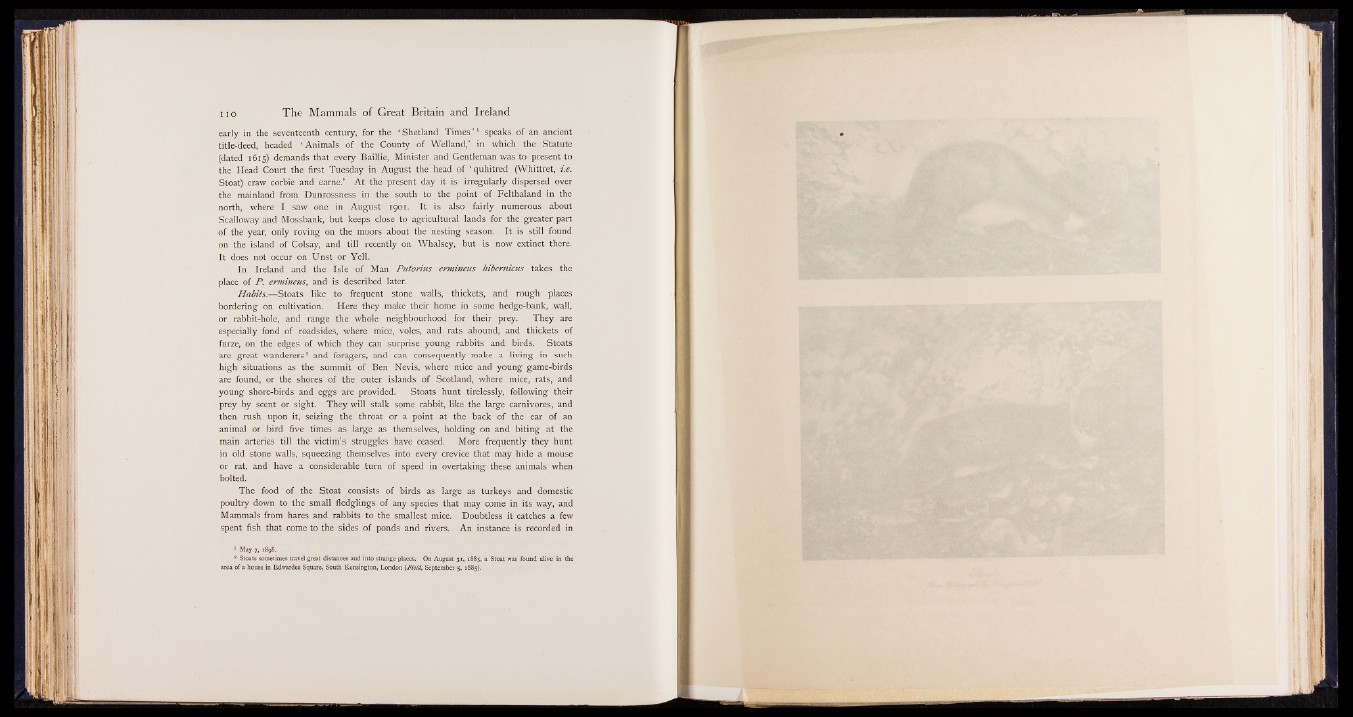
early in the seventeenth century, for the ‘ Shetland Times’ 1 speaks of an ancient
title-deed, headed ‘ Animals of the County of Welland,’ in which the Statute
(dated 1615) demands that every Baillie, Minister and Gentleman was to present to
the Head Court the first Tuesday in August the head of ‘ quhitred (Whittret, i.e.
Stoat) craw corbie and earne.’ At the present day it is irregularly dispersed over
the mainland from Dunrossness in the south to the point of Felthaland in the
north, where I saw one in August 1901. It is also fairly numerous about
Scalloway and Mossbank, but keeps close to agricultural lands for the greater part
of the year, only roving on the moors about the nesting season. It is still found
on the island of Colsay, and till recently on Whalsey, but is now extinct there.
It does not occur on Unst of Yell.
In Ireland and the Isle of Man Putorius ermineus hibernicus takes the
place of P . ermineus, and is described later.
H abits.—Stoats like to frequent stone walls, thickets, and rough places
bordering on cultivation. Here they make their home in some hedge-bank, wall,
or rabbit-hole, and range the whole neighbourhood for their prey. They are
especially fond of roadsides, where mice, voles, and rats abound, and thickets of
furze, on the edges of which they can surprise young rabbits and birds. Stoats
are great wanderers2 and foragers, and can consequently make a living in such
high situations as the summit of Ben Nevis, where mice and young game-birds
are found, or the shores of the outer islands of Scotland, where mice, rats, and
young shore-birds and eggs are provided. Stoats hunt tirelessly, following their
prey by scent or sight. They will stalk some rabbit, like the large carnivores, and
then rush upon it, seizing the throat or a point at the back of the ear of an
animal or bird five times as large as themselves, holding on and biting at the
main arteries till the victim’s struggles have ceased. More frequently they hunt
in old stone walls, squeezing themselves into every crevice that may hide a mouse
or rat, and have a considerable turn of speed in overtaking these animals when
bolted.
The food of the Stoat consists of birds as large as turkeys and domestic
poultry down to the small fledglings of any species that may come in its way, and
Mammals from hares and rabbits to the smallest mice. Doubtless it catches a few
spent fish that come to the sides of ponds and rivers. An instance is recorded in
1 May 7, 1898.
2 Stoats sometimes travel great distances and into strange places. On August 3 1, 1885, a Stoat was found alive in the
area of a house in Edwardes Square, South Kensington, London (Field, September 5, 1885).